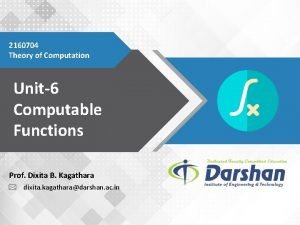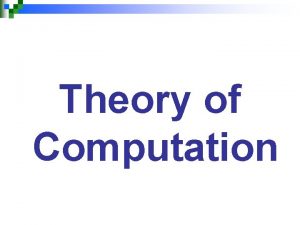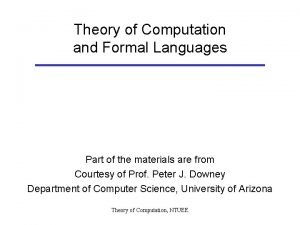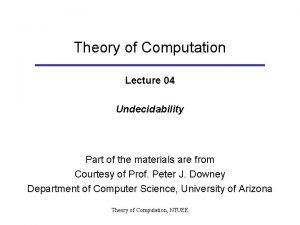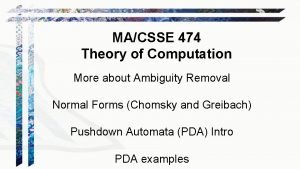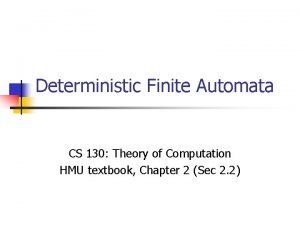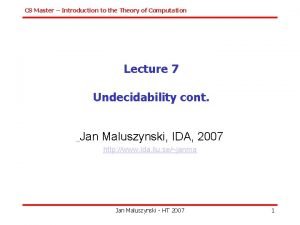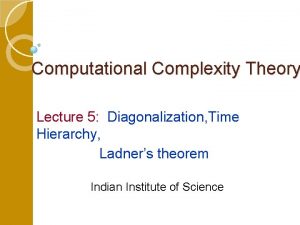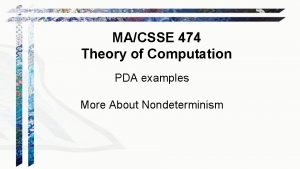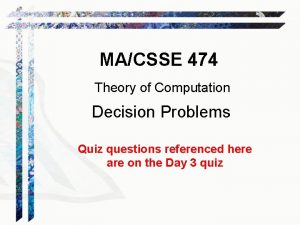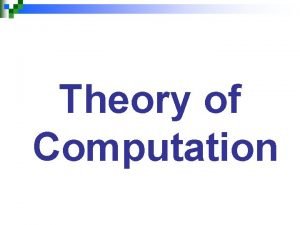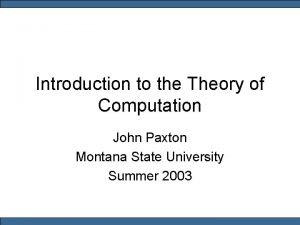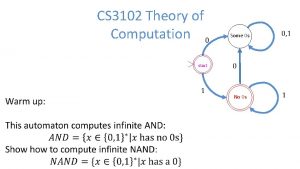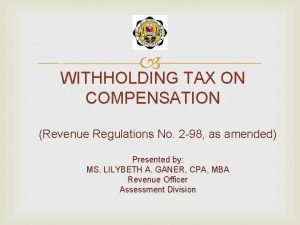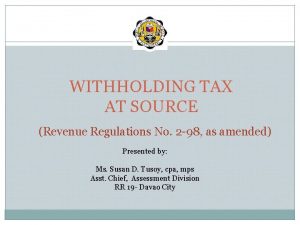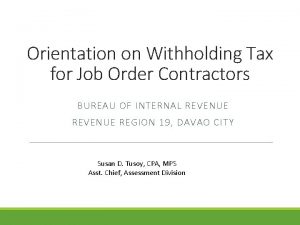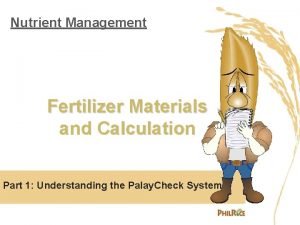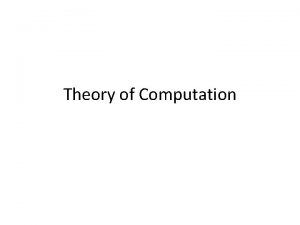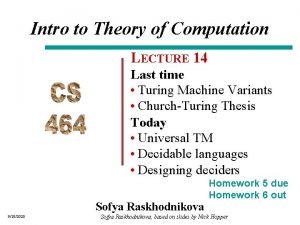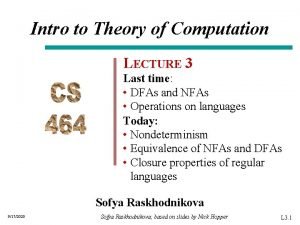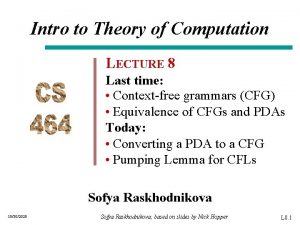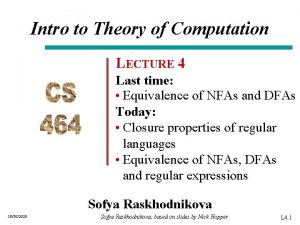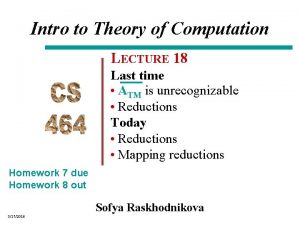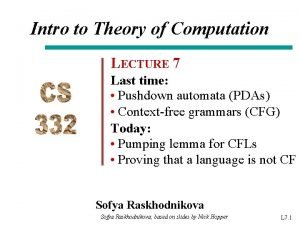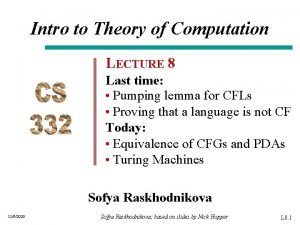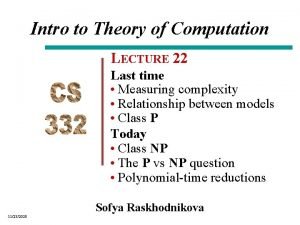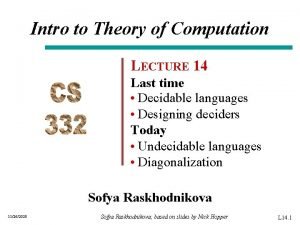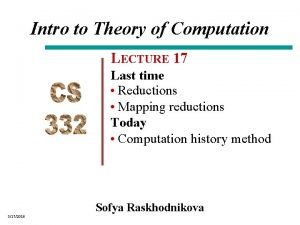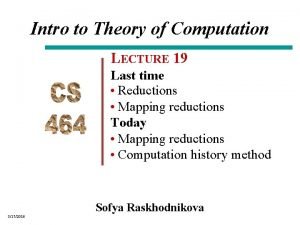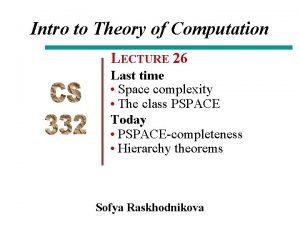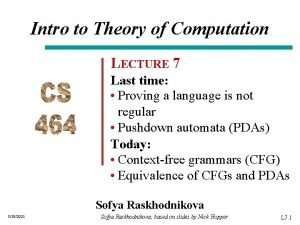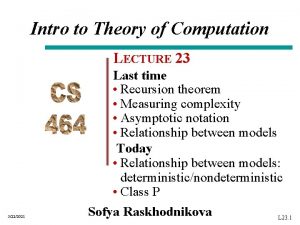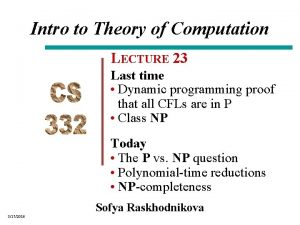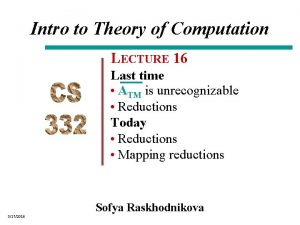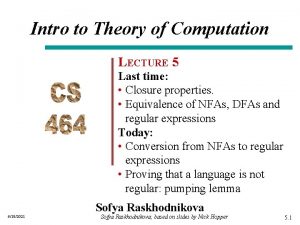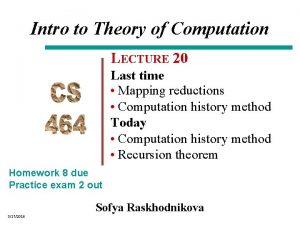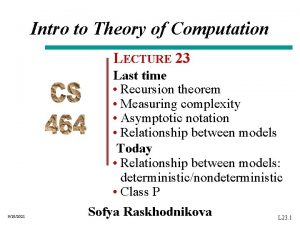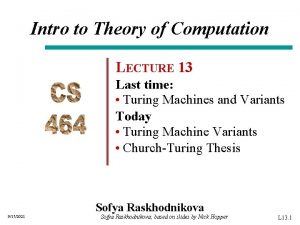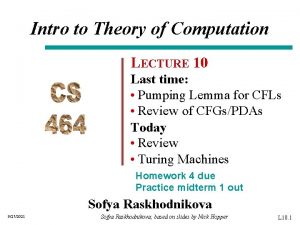Intro to Theory of Computation LECTURE 3 Last


























- Slides: 26

Intro to Theory of Computation LECTURE 3 Last time: • DFAs and NFAs • Operations on languages Today: • Nondeterminism • Equivalence of NFAs and DFAs • Closure properties of regular languages Sofya Raskhodnikova 11/27/2020 Sofya Raskhodnikova; based on slides by Nick Hopper L 3. 1

Nondeterminism Nondeterministic Finite Automaton (NFA) accepts a string w if there is a way to make it reach an accept state on input w. 0 ε 0 11/27/2020 Sofya Raskhodnikova; based on slides by Nick Hopper L 3. 2

Example 1 ε ε 11/27/2020 0 0 L(M)={1, 00} Sofya Raskhodnikova; based on slides by Nick Hopper L 2. 3

Example 0, 1 1 0, ε 1 L(M)={w | w contains 101 or 11} 11/27/2020 Sofya Raskhodnikova; based on slides by Nick Hopper L 2. 4

Exercise • 0 ε ε 0 0

Formal Definition • An NFA is a 5 -tuple M = (Q, Σ, , q 0, F) Q is the set of states Σ is the alphabet : Q Σε → P(Q) is the transition function q 0 Q is the start state F Q is the set of accept states • Σε = Σ {ε} and P(Q) is the set of subsets of Q • M accepts a string w if there is a path from q 0 to an accept state that w follows. 11/27/2020 Sofya Raskhodnikova; based on slides by Nick Hopper L 3. 6

Example 0, 1 q 0 0, 1 1 q 1 N = (Q, Σ, , q 0, F) Q = {q 0, q 1, q 2, q 3} Σ = {0, 1} F = {q 3} 11/27/2020 0, ε q 2 1 (q 0, 0) = (q 0, 1) = (q 1, ε) = (q 2, 0) = q 3 {q 0} {q 0, q 1, q 2} {q 1, q 2} Sofya Raskhodnikova; based on slides by Nick Hopper L 3. 8

Nondeterminism Deterministic Computation Nondeterministic Computation Ways to think about nondeterminism • parallel computation • tree of possible reject computations • guessing and verifying the “right” choice accept or reject 11/27/2020 accept Sofya Raskhodnikova; based on slides by Nick Hopper L 3. 9

NFAs ARE SIMPLER THAN DFAs A DFA that recognizes the language {1}: 0 0, 1 1 0, 1 An NFA that recognizes the language {1}: 1 11/27/2020 Sofya Raskhodnikova; based on slides by Nick Hopper L 3. 10

A DFA recognizing {1} Theorem. Every DFA for language {1} must have at least 3 states. Proof: 11/27/2020 L 3. 11

Equivalence of NFAs & DFAs Theorem. Every NFA has an equivalent DFA. Corollary: A language is regular iff it is recognized by an NFA. 11/27/2020 Sofya Raskhodnikova; based on slides by Nick Hopper L 3. 12

NFA to DFA Conversion Input: N = (Q, Σ, , q 0, F) Output: M = (Q , Σ, , q 0 , F ) Intuition: Do the computation in parallel, maintaining the set of states where all threads are. reject Idea: Q = P(Q) accept 11/27/2020 Sofya Raskhodnikova; based on slides by Nick Hopper L 3. 13

NFA to DFA Conversion Input: N = (Q, Σ, , q 0, F) Output: M = (Q , Σ, , q 0 , F ) Q = P(Q) : Q Σ → Q q 0 = F = { R Q | R contains some accept state of N} 11/27/2020 Sofya Raskhodnikova; based on slides by Nick Hopper L 3. 14

Example: NFA to DFA 1) 11/27/2020 a 1 b Sofya Raskhodnikova; based on slides by Nick Hopper L 3. 15

Examples NFA to DFA 0, 1 2) 1 ε 2 0 3 1 11/27/2020 Sofya Raskhodnikova; based on slides by Nick Hopper L 3. 16

NFA to DFA Conversion Input: N = (Q, Σ, , q 0, F) Output: M = (Q , Σ, , q 0 , F ) Q = P(Q) : Q Σ → Q r R q 0 = E({q 0}) F = { R Q | R contains some accept state of N} 11/27/2020 Sofya Raskhodnikova; based on slides by Nick Hopper L 3. 17

Regular Operations on languages Complement: A = { w | w A } Union: A B = { w | w A or w B } Intersection: A B = { w | w A and w B } Reverse: AR = { w 1 …wk | wk …w 1 A } Concatenation: A B = { vw | v A and w B } Star: A* = { w 1 …wk | k ≥ 0 and each wi A } 11/27/2020 Sofya Raskhodnikova; based on slides by Nick Hopper L 3. 18

Closure properties of the class of regular languages THEOREM. The class of regular languages is closed under all 6 operations. If A and B are regular, applying any of these operation yields a regular language. 11/27/2020 Sofya Raskhodnikova; based on slides by Nick Hopper L 3. 19

Palindromes A palindrome is a word or a phrase that reads the same forward and backward. Examples • mom • madam • Never odd or even. • Stressed? No tips? Spit on desserts! 11/27/2020 Sofya Raskhodnikova; based on slides by Nick Hopper L 3. 20

Exercise •

Closure under reverse Theorem. The reverse of a regular language is also regular • ε 11/27/2020 Sofya Raskhodnikova; based on slides by Nick Hopper ε ε L 3. 22

Construct an NFA M: L(MA)=A ε ε 11/27/2020 L(MB)=B Sofya Raskhodnikova; based on slides by Nick Hopper L 3. 23

Concatenation operation Concatenation: A B = { vw | v A and w B } Theorem. If A and B are regular, A B is also regular. Proof: Given DFAs M 1 and M 2, construct NFA by connecting all accept states in M 1 to the start state in M 2. ε L(M 1)=A L(M 2)=B ε 11/27/2020 Sofya Raskhodnikova; based on slides by Nick Hopper L 3. 24

Concatenation operation Concatenation: A B = { vw | v A and w B } Theorem. If A and B are regular, A B is also regular. Proof: Given DFAs M 1 and M 2, construct NFA by connecting all accept states in M 1 to the start state in M 2. • Make all states in M 1 non-accepting. ε L(M 1)=A L(M 2)=B ε 11/27/2020 Sofya Raskhodnikova; based on slides by Nick Hopper L 3. 25

Star operation Star: A* = { w 1 …wk | k ≥ 0 and each wi A } Theorem. If A is regular, A* is also regular. ε ε L(M)=A ε 11/27/2020 Sofya Raskhodnikova; based on slides by Nick Hopper L 3. 26

The class of regular languages is closed under Regular operations Union: A B = { w | w A or w B } Concatenation: A B = { vw | v A and w B } Star: A* = { w 1 …wk | k ≥ 0 and each wi A } Other operations Complement: A = { w | w A } Intersection: A B = { w | w A and w B } Reverse: AR = { w 1 …wk | wk …w 1 A } 11/27/2020 Sofya Raskhodnikova; based on slides by Nick Hopper L 3. 27
 01:640:244 lecture notes - lecture 15: plat, idah, farad
01:640:244 lecture notes - lecture 15: plat, idah, farad Sipser, m: introduction to the theory of computation
Sipser, m: introduction to the theory of computation 2160704
2160704 Transition diagram in theory of computation
Transition diagram in theory of computation Theory of machines
Theory of machines Theory of computation
Theory of computation Theory of computation
Theory of computation Theory of computation
Theory of computation Introduction to the theory of computation
Introduction to the theory of computation Time complexity hierarchy
Time complexity hierarchy Pda
Pda Theory of computation quiz
Theory of computation quiz Theory of computation
Theory of computation Nfa theory of computation
Nfa theory of computation The theory of computation
The theory of computation Cs 3102
Cs 3102 Randy pausch the last lecture summary
Randy pausch the last lecture summary Pengantar teori permainan
Pengantar teori permainan Natural language processing
Natural language processing Decision theory lecture notes
Decision theory lecture notes Bayesian decision theory lecture notes
Bayesian decision theory lecture notes Natural language processing nlp - theory lecture
Natural language processing nlp - theory lecture Wtax compensation table
Wtax compensation table Expanded withholding tax computation
Expanded withholding tax computation Expanded withholding tax computation
Expanded withholding tax computation Bir form 1901 job order
Bir form 1901 job order Fertilizer computation examples
Fertilizer computation examples


